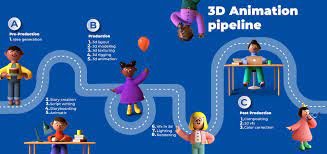What is Animation Pipeline? Why Pipeline is Important in Animation?
Animation Pipeline refers to the process of creating an animated film or video from start to finish. It involves the coordination of various departments, including storyboarding, concept art, modeling, rigging, animation, lighting, special effects, and compositing. The animation pipeline can vary depending on the studio, the type of project, and the technology used. However, there are some common steps involved in most animation pipelines. In this article, we will discuss the animation pipeline in detail.
- Concept and Story Development
The first step in the animation pipeline is to develop the concept and story of the project. This involves brainstorming ideas and coming up with a storyline that will be the basis for the animation. The story can be developed by a team of writers, artists, and directors who work together to create a compelling narrative.
Once the story has been developed, it is usually presented in the form of a storyboard. A storyboard is a series of illustrations that show how the story will unfold, shot by shot. This helps the team visualize the story and identify any potential issues before moving on to the next stage.
- Modeling
Once the storyboard has been approved, the next step is to create the 3D models that will be used in the animation. This involves building a 3D virtual world that will serve as the setting for the animation. The 3D models can be created using various software packages such as Maya, Blender, or 3ds Max.

The modeling stage involves creating the characters, props, and environments that will be used in the animation. The models are built using a variety of techniques, including polygonal modeling, NURBS modeling, and sculpting. Once the models have been created, they are often textured to give them a realistic appearance.
- Rigging
After the models have been created, the next step is to rig them. Rigging involves creating a digital skeleton for each character in the animation. This skeleton is used to control the movement of the character and give it a sense of weight and realism.
The rigging process can be quite complex, and it involves creating a series of controls that allow the animator to manipulate the character’s movements. This includes controls for the character’s arms, legs, head, and facial expressions.
- Animation
Once the characters have been rigged, the next step is to animate them. Animation involves bringing the characters to life by creating a series of movements that make them appear to move and interact with their environment.
The animation process can be quite time-consuming, and it involves creating a series of keyframes that define the character’s movements over time. The animator then fills in the gaps between the keyframes to create a smooth and fluid animation.
- Lighting
Once the animation has been completed, the next step is to light the scene. Lighting is an important aspect of the animation process, as it helps to create the mood and atmosphere of the scene.

The lighting process involves creating light sources within the scene and positioning them to create the desired effect. This can involve creating shadows, highlights, and other visual effects that help to enhance the scene.
- Special Effects
Special effects are often added to the animation to enhance its visual appeal. This can include particle effects, explosions, and other visual elements that help to create a sense of drama and excitement.
Special effects are created using various software packages, including Houdini and After Effects. They are often added during the compositing stage.
- Compositing
The final stage of the animation pipeline is compositing. This involves bringing all of the elements together to create the final image or video. Compositing involves combining the various elements of the animation, including the characters, environments, lighting, and special effects.
Why Pipeline is Important in Animation?
The animation pipeline is a vital component of the animation production process. It serves as a roadmap for creating animated content and ensures that the final product is of the highest quality possible. The pipeline helps to streamline the production process by breaking it down into manageable stages and providing a clear framework for each stage of the animation process.
There are several reasons why the animation pipeline is so important in animation production.

- Improves Efficiency and Speed
One of the most significant advantages of using an animation pipeline is that it improves efficiency and speed. By breaking the production process down into smaller, manageable stages, the team can work more efficiently and quickly. Each team member knows what their role is and what is expected of them at each stage of the process. This helps to reduce the time and cost involved in the production process.
- Ensures Consistency and Quality
The animation pipeline also ensures consistency and quality throughout the production process. By establishing clear standards and guidelines for each stage of the process, the team can maintain a consistent level of quality in their work. This helps to ensure that the final product is of a high standard and meets the expectations of the client and the audience.
- Allows for Better Collaboration
The animation pipeline also allows for better collaboration between the different departments involved in the production process. Each department knows what their role is and how their work fits into the larger picture. This helps to promote teamwork and collaboration between the different departments, which is essential for creating high-quality animated content.
- Facilitates Iteration and Revision
The animation pipeline also facilitates iteration and revision. As the production process moves forward, the team can review their work and make changes as needed. This allows them to refine their work and make improvements to the animation until it meets their desired standards. The pipeline also allows for revisions to be made at any stage of the process, ensuring that the final product is the best it can be.

- Provides a Clear Path to Completion
The animation pipeline provides a clear path to completion for the project. The team knows what needs to be done at each stage of the process, and they can work towards completing each stage in turn. This helps to ensure that the project stays on track and that it is completed on time and within budget.
- Helps Manage Resources
The animation pipeline also helps to manage resources effectively. By breaking the production process down into smaller stages, the team can allocate resources more effectively. This helps to ensure that resources are used efficiently and that the project stays within budget.
- Enables Scalability
The animation pipeline also enables scalability. As the size and scope of the project increase, the pipeline can be adjusted to accommodate the additional resources and complexity involved. This helps to ensure that the project can be scaled up or down as needed to meet the demands of the project.
In conclusion, the animation pipeline is an essential component of animation production. It helps to streamline the production process, improve efficiency and speed, ensure consistency and quality, facilitate collaboration, allow for iteration and revision, provide a clear path to completion, manage resources effectively, and enable scalability. By using an animation pipeline, animation studios can create high-quality animated content that meets the expectations of their clients and their audience.







